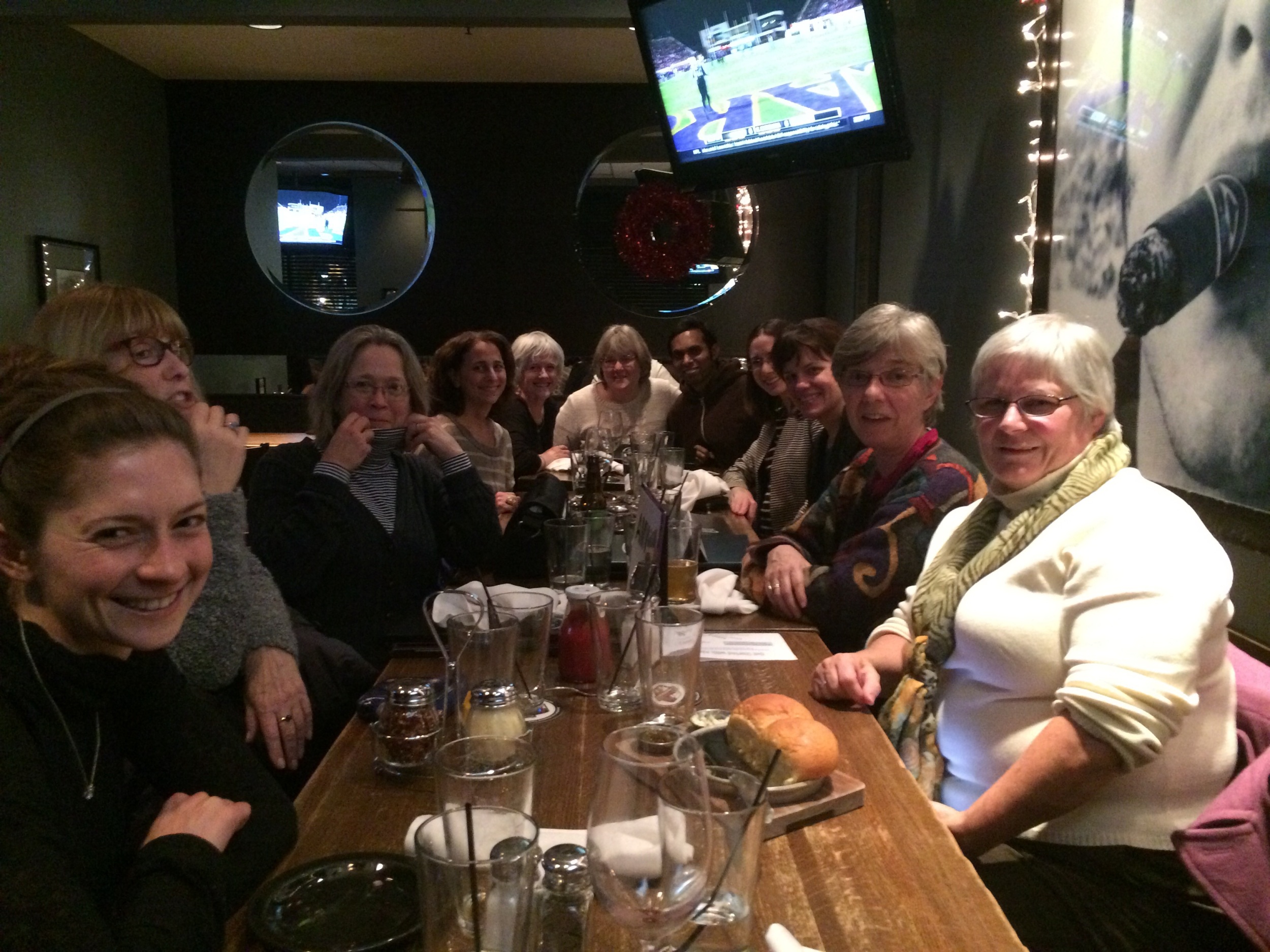Newsletter – December 2014
Contents
November Event Summary: Toward Understanding the Brain
Upcoming Book Club meeting
Happy Hour Networkers
Toward Understanding the Brain
Author: Elizabeth Fehrmann, AMWA member and R&D Engineer at Medtronic
Although scientists have tried to understand the human brain for centuries, there is much about its function and (occasional) dysfunction we still don’t understand. The launch of the US government- supported BRAIN Initiative last year sparked renewed interest in understanding the brain and developing and improving treatments for neurological disorders. Medtronic Neuromodulation, with its history of developing implantable medical devices to treat symptoms of neurological disorders, is building tools that clinicians and other neuroscience researchers can use to help further our collective understanding of the brain.
On Saturday, November 1, the AMWA North Central Chapter hosted Tim Denison, PhD, the Senior Engineering Director of Technology from Medtronic Neuromodulation for a talk titled “Technological Advancements in Neurological Disorders.” Tim shared his thoughts and provided some context for the current state of brain research, as well as Medtronic Neuromodulation’s role in this research.
 Tim began his talk with some background on how neurostimulation devices—effectively pacemakers for the brain and spinal cord—have been used in the past. There are some neurological disease symptoms that can be treated by directly accessing and stimulating the brain using electrical pulses; this type of treatment is called “deep brain stimulation” (DBS) or simply “brain modulation.” For example, brain modulation has been used to reduce the severity of motion-induced tremors in patients with essential tremor; in some patients, as soon as the electrical therapy is delivered, the tremors subside. (“Who’s read Terminal Man?” queried Tim, making a connection to popular science and some of the challenges facing neurotechnologists today.)
Tim began his talk with some background on how neurostimulation devices—effectively pacemakers for the brain and spinal cord—have been used in the past. There are some neurological disease symptoms that can be treated by directly accessing and stimulating the brain using electrical pulses; this type of treatment is called “deep brain stimulation” (DBS) or simply “brain modulation.” For example, brain modulation has been used to reduce the severity of motion-induced tremors in patients with essential tremor; in some patients, as soon as the electrical therapy is delivered, the tremors subside. (“Who’s read Terminal Man?” queried Tim, making a connection to popular science and some of the challenges facing neurotechnologists today.)
But how does it work? Why does it work? How do we move forward, Tim wondered, when we aren’t sure of the principles of operation—the mechanisms of action—of the brain from a basic neuroscience perspective? What happens when we get outcomes that seem to be counter to our expectations? Tim referred to a paper by Peter Brown, MD and Alexandre Eusebio, MD, titled “Paradoxes in Functional Neurosurgery: Clues from Basal Ganglia Recordings” (Movement Disorders, 2007;23(1):12-20), which provides specific examples of some seemingly contradictory characteristics of brain modulation.
Today, clinicians make all the decisions regarding therapeutic effectiveness in the neurological disorder treatment path, including diagnosis, treatment, and ongoing adjustments to therapy. Every step requires clinician intervention and, ideally, ready access to a vast and deep knowledge of the brain. But what happens when we don’t really know that much?
What if we could aid physicians in their understanding by providing them with a set of tools that gives them access to the brain in a whole new way, Tim asked. What if Medtronic could help make understanding the brain easier? Since Medtronic specializes in developing chronic implants to deliver electrical stimulation, what would happen if we built on what we already have to perform research without perturbing the baseline therapy?
In answer to these questions, engineers and scientists at Medtronic Neuromodulation took a device designed to deliver stimulation therapy in the brain and added sensors for retrieving brain signals on top of the basic neurostimulator design. Tim explained that these new devices provide the capability of observing variations in the brain’s rhythms, similar to listening to the “roar of a crowd” (versus eavesdropping on a single conversation). He maintained that even listening to changes in the roar of the crowd—when obtained over months and years—can provide us with new, valuable insights into the response and evolution of chronic neurological diseases over time.
However, Tim cautioned, think back to the invention of the airplane. Very quickly, those interested in harnessing the power of flight discovered the difference between being able to capture the wind and being able to control the operation of the wind-capturing device. The first attempts at flight were dismal failures because they lacked a fundamental understanding of the physics of aviation. When the Wright brothers took the problem “back to basics” through capturing data, understanding the concepts of lift and drag, and modifying designs to reflect their new knowledge, they began to see their first real successes.
Similar to those early attempts at flight, Medtronic’s sensing-capable neurostimulation devices are now able to capture chronic information about the brain. However, said Tim, without a true understanding of the brain’s operation, we will be unable to produce the precise clinical outcomes we would like to see with full reliability and repeatability (i.e., eliminate the unwanted effects of the neurological disorder without producing undesirable side effects).
To date, Medtronic has delivered the sensing-capable neurostimulator device to research partners around the globe and is in the beginning phases of several learning cycles, keeping the therapy decision loop open by involving experts to help identify additional truths about neurological disorders and their treatments. Once Medtronic and its research partners have a better understanding of neurological disorders, said Tim, the Medtronic Neuromodulation team of engineers and scientists are ready and waiting to develop solutions to increase the effectiveness of neurological disorder treatments.
In the end, even though we may have a long way to go in our understanding of the human brain, Tim’s outlook was decidedly upbeat: “No matter what we find, it’s interesting!”
Book Club Meeting
The North Central AMWA book club will meet at 11 a.m. on Monday, January 26, 2015, at the group’s longtime lunch spot, The Egg & I (2550 University Ave., just west of Hwy. 280 near the Minneapolis-St. Paul border).
Over a meal or, if you’d prefer, just a snack or beverage—whatever your stomach desires—we will be discussing Gulp: Adventures on the Alimentary Canal by Mary Roach. Even if you don’t overindulge overmuch during the holidays, Gulp should be a timely read.
If you plan to attend, please email Mary Knatterud ( k…@umn.edu) by 9:00 a.m. that Monday morning (1-26-15) or leave her a brief voicemail (651-645-3858) so that she can phone in an accurate reservation. As always, even if you haven’t started or finished this book, feel free to come and chime in anyway. The small group of attendees varies from time to time: new and/or lapsed AMWA Book Club fans are always welcome.
AMWA Social Networking
Current and prospective members of AMWA’s North Central chapter gathered for drinks and appetizers (the latter courtesy of the chapter), as well as the opportunity to catch up and network with colleagues. The group met December 4 at McCoy’s Public House in St. Louis Park.
Look for additional happy hour events in 2015!

